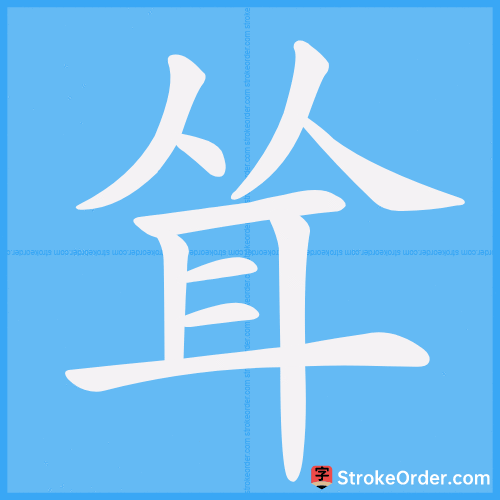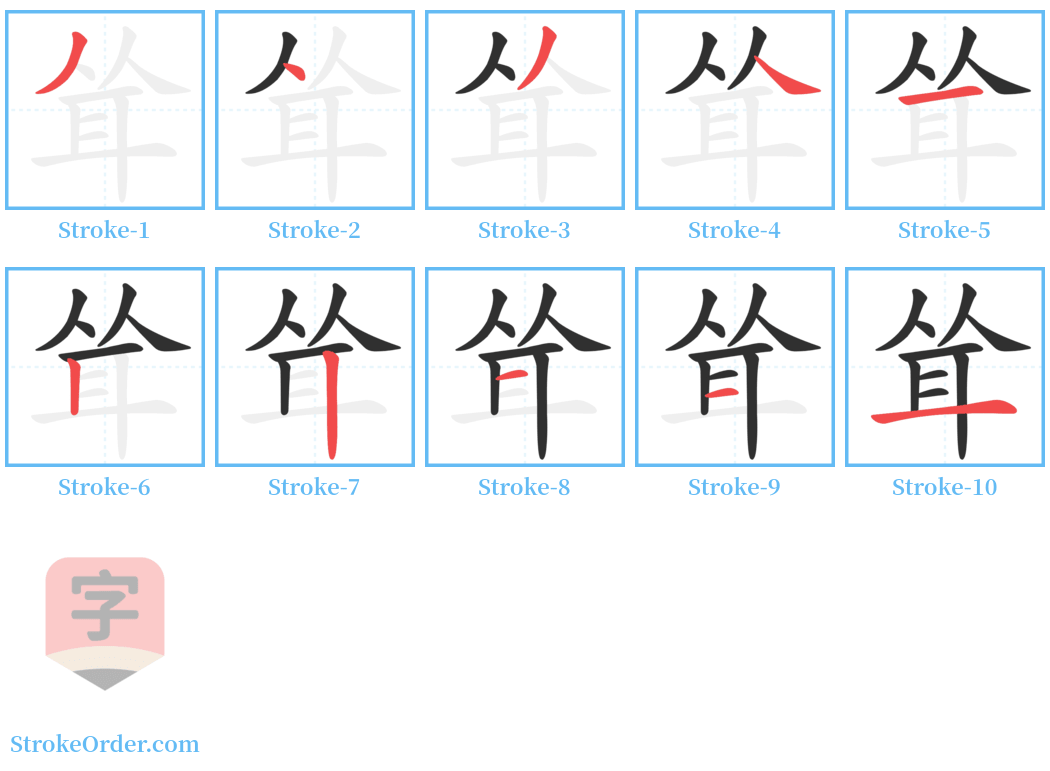耸 Stroke Order
Animated Stroke Order of 耸

Stroke Order Diagrams for 耸

Step-by-Step Handwriting Guide for 耸

Learn to Write Chinese Characters with Video Tutorials
Watch the video of writing the Chinese character "耸", learn the correct stroke order (笔顺) of the character "耸", and master the standard way of writing the character "耸".
Free Printable Handwriting Practice with Stroke Order: 耸
Printable Writing Practice Worksheet of "耸" in Portrait Orientation (Tian Zi Ge)

Printable Writing Practice Worksheet of "耸" in Landscape Orientation (Tian Zi Ge)

Information of 耸
Pinyin
sǒng
Radical
耳
Strokes
10 strokes
Usage
★★★★★
Definition
excite / raise up / to shrug / high / lofty / towering
耸
sǒng
1. 高起,直立。
High and upright; towering.
Example: 高~入云 (highly reaching into the clouds).
2. 惊动。
To alarm; to disturb.
Example: ~动 (to get shocked).
3. 聋。
Deaf.
Example: ~昧 (being both deaf and blind, metaphorically referring to being oblivious).
耸
sǒng
(形)
(Phonetic compound: from "ear" and "sound"; original meaning: deaf) Same as the original meaning (English: deaf).
引例:
1. 马融《广成颂》:子野听耸,离朱目眩。
(Mǎ Róng's poem: Ziyě listens, his eyes dazzled by the red.)
2. 《方言》:耸,聋也…生而聋,陈、楚、江、淮之间谓之耸。荆阳之间及山之东西双聋者谓之耸。郭璞注:“言无所闻常耸耳也。”
(In dialect: "Sǒng" refers to being deaf. In areas between Chen, Chu, Jiang, and Huai, it is referred to as sǒng when someone is born deaf. Guō Pǔ notes: "It means not hearing anything often makes one's ears sǒng.")
例子:
如: 耸昧 (being both deaf and blind).
耸
sǒng
(动)
1. 高起; 矗立 (English: shoot high up; lofty; towering).
引例:
1. 宋·沈括《梦溪笔谈》:予观雁荡诸峰,皆峭拔险,上耸千尺。
(Song Dynasty's Shěn Kuò: I observe the peaks of Yàn Dàng, all steep and perilous, towering thousands of feet high.)
例子:
如: 耸人瞻仰 (people standing in awe); 耸秀 (lofty and elegant); 耸出 (prominently rising); 耸耳 (ears that are upright); 耸然 (appearing lofty); 耸峭 (high and steep); 耸突 (protruding tall); 耸干 (erect tree trunk); 耸擢 (standing tall); 耸耸 (upright in appearance).
2. 比喻出众,不凡 (English: outstanding).
引例:
1. 唐·李朝威《柳毅传》:又有一人,披紫裳,执青玉,貌耸神溢,立于君左。
(Tang Dynasty's Lǐ Zhāowēi: There was another person, dressed in purple with a green jade, who stood at the king's left, striking in appearance and spirit.)
例子:
如: 耸壑昂霄 (standing high between valleys, reaching into the sky; metaphorically refers to being outstanding).
3. 向上跳; 向上动 (English: jump up; draw up suddenly).
例子:
如: 耸擢 (to leap); 耸体 (to rise).
4. 劝勉 (English: advise).
引例:
1. 《国语·楚语上》:教之春秋而为之,耸善而抑恶焉。
(Guó Yǔ: Teach them about spring and autumn, advising them to encourage good and suppress evil.)
例子:
如: 耸恿 (to advise); 耸劝 (to counsel; alert oneself).
5. 通“怂”。怂恿 (English: instigate).
例子:
如: 耸恿 (instigate); 耸踊 (to instigate).
6. 惊动; 惊惧 (English: alarm; shock; alert).
引例:
1. 《左传·昭公元年》:耸之以行。
2. 《左传·昭公十九年》:驷氏耸。
3. 《国语·周语下》:身耸除洁。
4. 刘禹锡《观柘枝舞》:体轻似无骨,观者皆耸神。
(Various references about alarming or shocking people.)
例子:
如: 危言耸听 (dangerous words can cause shock); 耸惧 (fearful); 耸激 (to excite).
tall and erect, reaching through the clouds (idiom); used to describe tall mountain or skyscraper
Input Method for 耸
Pinyin
song3
Wubi
wwbf
Cangjie
oosj
Zhengma
odoc
Four Corner
88401
Unicode
U+8038
Same Pronunciation Characters